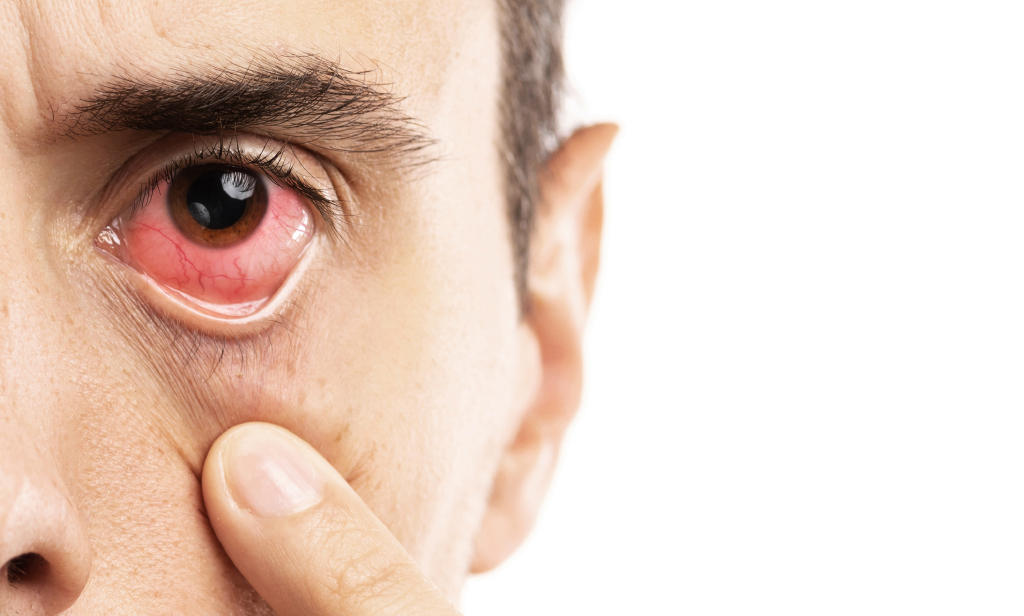Conjunctivitis Often referred to casually as “pink eye”, conjunctivitis is the swelling or inflammation of the conjunctiva, the thin, transparent layer of tissue that lines the inner surface of the eyelid and covers the white part of the eye. Causes may or may not be infectious.
Causes & risk factors
There are three main types of conjunctivitis: allergic, infectious, and chemical. The cause of conjunctivitis varies depending on the type.
Allergic conjunctivitis
- Allergic conjunctivitis occurs more commonly among people who already have seasonal allergies. They develop it when they come into contact with a substance that triggers an allergic reaction in their eyes.
- Giant papillary conjunctivitis is a type of allergic conjunctivitis caused by the chronic presence of a foreign body in the eye. People who wear hard or rigid contact lenses, wear soft contact lenses that are not replaced frequently, have an exposed suture on the surface of the eye or have a prosthetic eye are more likely to develop this form of conjunctivitis.
Infectious conjunctivitis
- Bacterial conjunctivitis is an infection that is often caused by staphylococcal or streptococcal bacteria. Insects, physical contact with other people, poor hygiene (touching the eye with unclean hands), cause the infection.
- Viral conjunctivitis is most commonly caused by contagious viruses associated with the common cold. It can develop through exposure to the coughing or sneezing of someone with an upper respiratory tract infection.
- Ophthalmia neonatorum is a severe form of bacterial conjunctivitis that occurs in newborn babies. This is a serious condition that could lead to permanent eye damage if it is not treated immediately.
Chemical conjunctivitis
Chemical Conjunctivitis can be caused by irritants like air pollution, chlorine in swimming pools, and exposure to noxious chemicals.
Symptoms
Allergic symptoms
- Watery discharge
- Mild redness.
- Itching,
- Yellow/green discharge.
- Crusty eyelids.
Bacterial infections
- Severe discomfort
- Light sensitivity.
- Redness in eyes.
- A sandy, gritty feeling.
Diagnosis
Comprehensive eye examination is the best way to diagnose conjunctivitis. Testing, with special emphasis on the conjunctiva and surrounding tissues, may include:
- Patient history
- Visual acuity
- Evaluation of the conjunctiva
- Evaluation of the inner structures of the eye
- Supplemental testing
Using the information obtained from these tests, a doctor of optometry can determine if you have conjunctivitis and provide treatment options.
Treatment
Treating conjunctivitis has three main goals:
- Increase patient comfort.
- Reduce or lessen the course of the infection or inflammation.
- Prevent the spread of the infection in contagious forms of conjunctivitis.
The appropriate treatment for conjunctivitis depends on its cause.
Allergic conjunctivitis
The first step is to remove or avoid the irritant, if possible. Cool compresses and artificial tears sometimes relieve discomfort in mild cases. In more severe cases, nonsteroidal anti-inflammatory medications and antihistamines may be prescribed. People with persistent allergic conjunctivitis may also require topical steroid eye drops. Some prescribe oral antihistamines.
Infectious conjunctivitis
We generally use antibiotic eye drops or ointments to treat this type of conjunctivitis. Bacterial conjunctivitis may improve after three or four days of treatment. But, patients should complete the entire course of antibiotics to prevent a recurrence.
Viral conjunctivitis
No drops or ointments can treat viral conjunctivitis and antibiotics too will not cure a viral infection. Like a common cold, the virus has to run its course, which may take up to two or three weeks. Relieve such symptoms with cool compresses and artificial tear solutions. For the worst cases, topical steroid drops reduce the discomfort from inflammation. However, these drops will not shorten the infection. The viral infection Epidemic Keratoconjunctivitis (EKC) is very contagious and is the red eye most associated with the term “pink eye”.
Chemical conjunctivitis
Careful flushing of the eyes with saline is a standard treatment for chemical conjunctivitis. People with chemical conjunctivitis also may need to use topical steroids. Severe chemical injuries, particularly alkali burns, are medical emergencies and can lead to scarring, damage to the eye or the sight, or even loss of the eye. If chemical spills in your eye, flush the eye for several minutes with a lot of water before seeing your medical provider. Practicing good hygiene is the best way to control the spread of conjunctivitis.
- Don’t touch your eyes with your hands.
- Wash your hands thoroughly.
- Change your towel daily.
- Discard eye cosmetics.
- Follow your eye doctor’s instructions.
Prevention
With so many causes, there is no one preventive measure. Early diagnosis and treatment will help prevent the condition from becoming worse. Also, avoiding allergy triggers as much as possible also helps. Frequent hand washing and keeping hands away from the eyes too makes a difference.
Conclusion
For detailed consultation, you can contact us at Abhinav Multispeciality Hospital. It is one of the most trusted and best hospitals in Nagpur. You can consult Dr. Bhakti Bhatnagar at Abhinav Multispeciality Hospital in Bajeria, Nagpur. Dr. Bhakti Bhatnagar is a popular Ophthalmologist in Bajeria, Nagpur. The hospital has the best medical facility in Nagpur. The doctor has been practicing Ophthalmology for over a decade. She is among the best ophthalmologist in Nagpur. The doctor is a qualified Post Graduate Diploma in Ophthalmology, DNB – Ophthalmology, FELLOW OF INTERNATIONAL COUNCIL OF OPHTHALMOLOGY.

